What Weight Fly Rod For Steelhead? For All Conditions
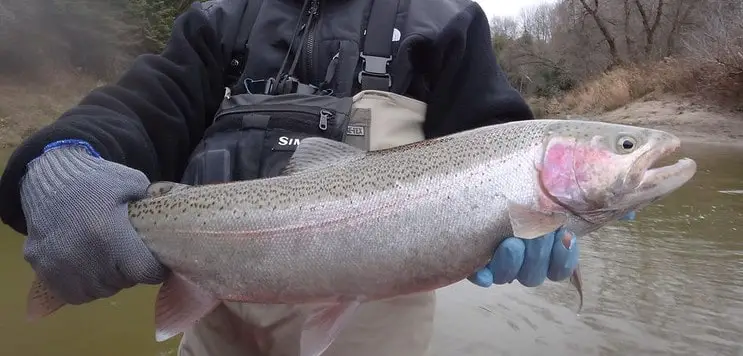
I’ve been teaching anglers how to fly fish for steelhead for over 20 years and the question of what weight fly rod for steelhead has come up plenty of times.
The answer is not as cut and dry as just saying an 8-weight fly rod is best for steelhead because there are many variables that determine the fly rod weight.
Consider these things when choosing a fly rod weight for steelhead.
- The size of the steelhead
- The fly fishing method use
- The size of the fly
- The size of the water
- The potential for high winds
- The geographical area (West Coast or Great Lakes)
So, let’s find out what the right weight fly rod for Steelhead is!
What Kind Of Fly Rod Should You Use to Target Steelhead?
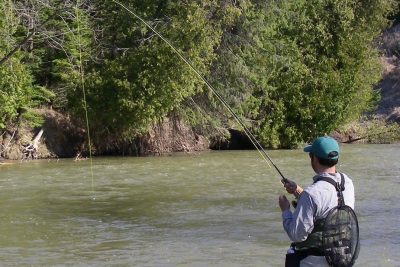
Steelhead trout can migrate into large, open rivers, or small, close-quarter streams. Different freshwater environments and conditions require different fishing strategies and equipment.
Be sure to check out my page The 7 Best Rated Fly Rods For Steelhead.
West Coast Steelhead Versus Great Lakes Steelhead
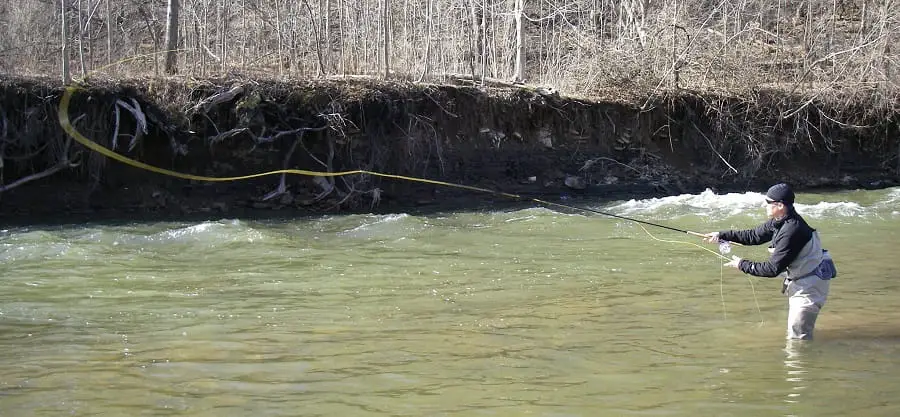
Believe it or not, there is a difference between the two fish. Take it from me, I’ve spent a lot of time fishing West Coast Steelhead, and even more time fishing and guiding for Great Lakes steelhead, and in my opinion, you need a stronger fly rod for West Coast steelhead.
What Weight Fly Rod For Steelhead On West Coast Rivers And Why?
West Coast Steelhead as far south as California or as far north as Alaska seam to be slightly stronger than the Great Lakes Steelhead.
I don’t know if it’s the salt water that makes them stronger, but they are.
For West Coast steelhead, the best choice would be an 8-weight fly rod paired with a high-capacity fly reel and matching fly line.
Some anglers will even go up to a nine-weight for various reasons. In general, I can handle most Alaskan Steelhead streams with a one-handed 9 or 10-foot, 8 or 9-weight fly rod.
I recommend a good smooth drag to battle the aggressive Steelhead and a strong rod that can put the boots to them.
This might change based on the river size and the method I choose to fish with, or whether or not I want a rod for multiple methods. I’ll discuss river sizes and methods below.
I will sometimes use a two-handed Steelhead fly rod for the larger rivers (for example, those on the Alaska Peninsula or Southwestern Alaska). In this case, we suggest using an 8-weight, 12’6″-13’6″ Spey rod.
For nymphing, I use 10’6″ to 11’9″, 7 or 8-weight switch rod. Switch rods allow you to change from nymphing to swinging whenever you wish.
Then there is streamer fishing for West Coast steelhead, which also requires different fly rods.
What Weight Fly Rod For Steelhead On Great Lakes Rivers And Why?
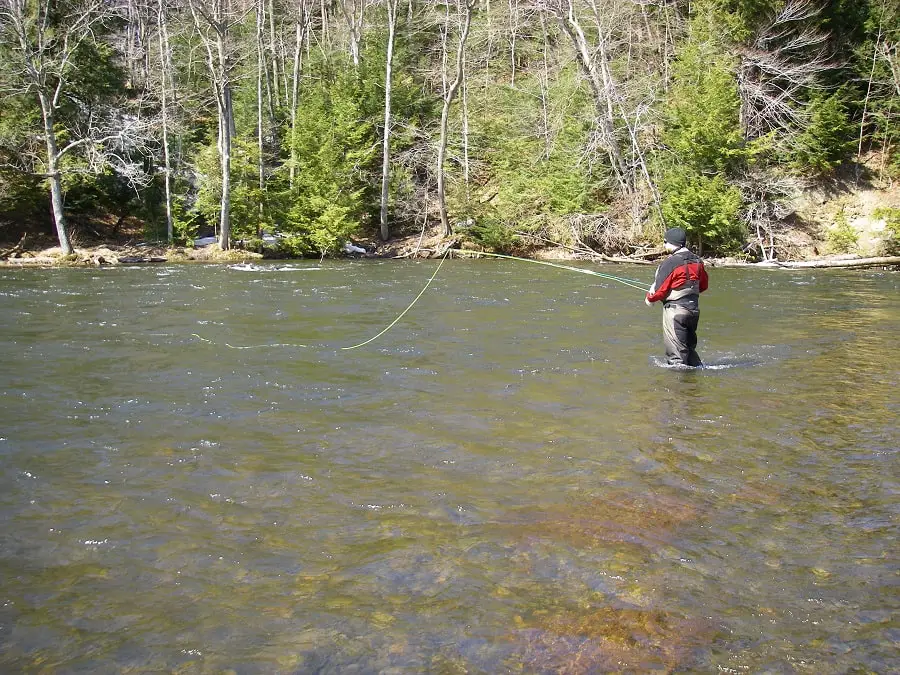
My go-to rod for fishing and guiding for Great Lakes Steelhead is a 10-foot 7-weight single-hand rod. It works great with or without an indicator.
I have even used 10-foot and 11-foot 6-weight fly rods for over 20 years. A 6-weight will help avoid shoulder pain or fatigue while securing enough power to handle large fish.
Alternatively, many fly shops around the Great Lakes, and some so-called experts recommend using 8 weights for Great Lakes steelhead, but I think an 8 weight is unnecessary for 90% of Great Lakes rivers and streams.
There are 3 simple reasons why I do not recommend an 8-weight for Great Lakes steelhead:
- The steelhead are smaller on average and not as strong.
- Most rivers are less than 70 feet wide so I don’t need a powerful rod to make long casts into the wind.
- Most great lakes steelhead are line sensitive and lighter leaders are required, so there is no need for all that backbone in an eight-weight fly rod.
I also use the 11-foot 6 or 7-weight switch rod. Switch rods are a hot trend in the Great Lakes area. This Switch rod allows anglers to choose between numerous casting styles and fishing techniques.
In general, a 7 or 8-weight rod should be used on larger rivers, and a 6-weight or 7-weight rod should be reserved for Steelhead fishing on smaller tribs like those found in Pennsylvania or Ohio.
What Fly Rod Weight For Steelhead In Small Streams And Why?
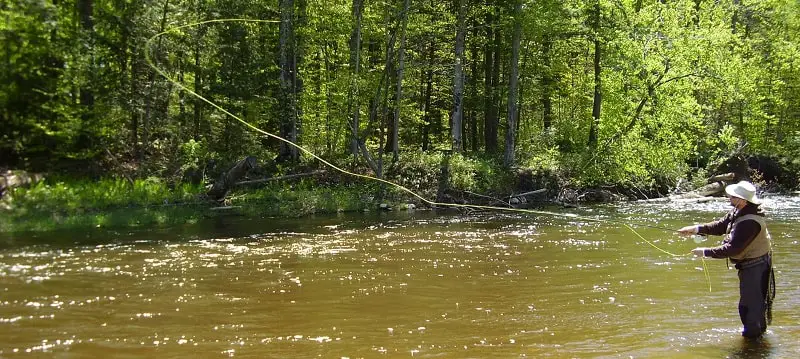
When fishing smaller rivers, a good-weight fly rod for steelhead can be slightly smaller than what I would need on larger rivers.
West Coast Steelhead: Seven-weight fly rods are the best choice for Steelhead fishing in small streams on the West Coast.
Great Lakes Steelhead: A 6-weight fly rod is good for small streams around the Great Lakes.
The reasons for such light fly rods for steelhead are simple:
- Small stream steelhead can be line shy, so smaller tippets are needed, therefore there is no need for a heavier rod.
- On small streams, the fish don’t often have the ability to run as far or as fast, and even if they do run up or down the river, I can walk the bank and chase them.
What Fly Rod Weight For Steelhead In Big Rivers And Why?
Large West Coast Steelhead rivers require the use of “heavy fly rods”. Therefore the best Steelhead fly rod for this occasion is a 9-weight rod. These rods can cast long distances and are best for casting the heavier-weighted rigs that are sometimes required on large rivers.
Great Lakes have some very large rivers, such as the Niagara River, and the St. Mary’s River. These large rivers are bigger, and deeper, and require heavier rigs. The heavier line also helps me cast into the wind.
Therefore, the best rod for very large Great Lakes rivers is an 8-weight fly rod.
Spey Fly Rod Weights For Steelhead
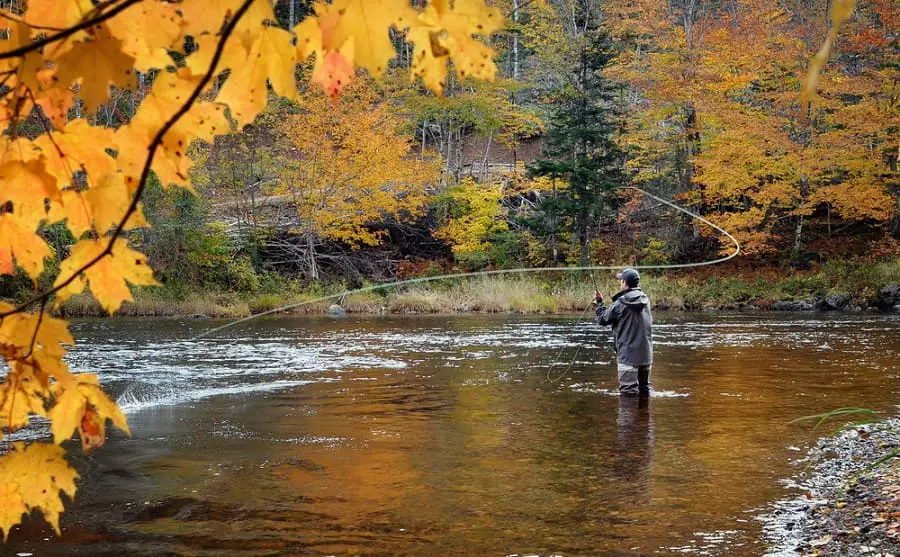
At the moment, Spey rods are growing in popularity for targeting Steelhead. They are two-handed rods that require a bit of a complex casting technique known as a spey cast.
There are many different spey casts but for steelhead, Skagit casting big streamers and heavy sink tips seem to be most popular. This is what I do the most.
Scandi spey fishing is also good and is geared more toward slightly lighter flies and lighter sink tips that are used in shallower and wider sections of the river.
If you learn to spey fish for steelhead, you will be able to launch big flies and heavy sinking lines at long distances with very little backcast room.
A Spey rod will allow me to cover a lot of water while standing near the shore with very little free space behind me. This is because the spey cast rarely goes more than 20 feet behind the angler casting.
If you have never used a Spey rod, you might want to know that weight is the first thing you need to consider. Namely, a 5-weight Spey rod feels and behaves about the same as a 7-weight one-handed rod.
West Coast Steelhead Spey Rod Weight: A 7 or 8-weight Spey rod would be good for most small to mid-sized steelhead rivers. A 9 weight may be required for extra large and deep rivers that require heavier sink tips and further casts.
Great Lakes Steelhead Spey Rod Weight: A 5 or 6-weight spey rod would be sufficient for most small to midsized Great Lakes rivers, and a 7 or 8-weight would be best on large to very large rivers.
If you are into Spey fishing, check out my buddies at Alley Grabs Guide Service In Ohio and A Perfect Drift Guide Service In Ontario.
Also check out the article, Spey Fishing For Steelhead.
Switch Rods Weights For Steelhead
If you cannot choose between a light one-handed rod for nymphing or a massive Spey rod, go for a middle-ground solution and get a switch rod. Switch rods can be an excellent tool for targeting Steelhead and allow the angler to nymph with indicators or spey cast with streamers.
Switch rods enable anglers to cast long distances just like Spey rods but can also be used for one-handed casts when the distance is shorter. It can be a win-win situation when you chase Steelhead in different freshwater environments that call for a completely different approach.
What Weight Fly Rod For Nymphing Steelhead
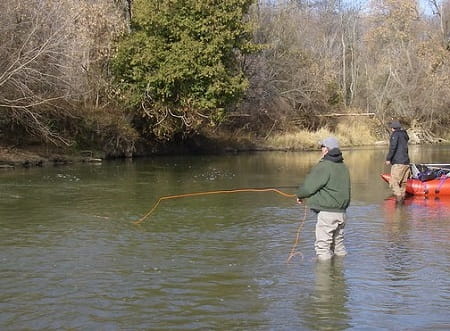
When Nymph Fishing, I use longer fly rods of 10 or 11-foot in the 7 or 8-weight size.
The most suitable fly rod for Steelhead nymphing around the Great Lakes is a 10-foot 7-weight.
On the West Coast, an 8-weight 10-foot is a great nymphing rod.
What Fly Rod Weight For Steelhead When Streamer Fishing
Great Lakes Streamer Steelhead Rod Weight: For streamer fishing, the perfect Steelhead fly rod for the Great Lakes would be an 8-weight rod in a 9-foot length. It is an ideal choice for casting long distances. It also performs well in open areas and high wind conditions.
West Coast Streamer Steelhead Rod Weight: The ideal rod for West Coast steelhead streamer fishing would be a 9-weight fly rod in 9-foot length.
Tight Lines,
Graham
